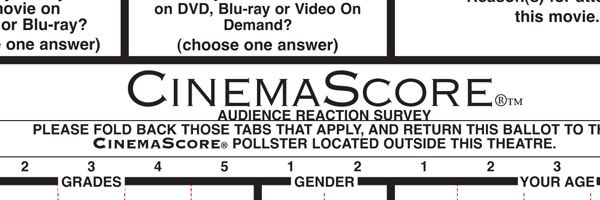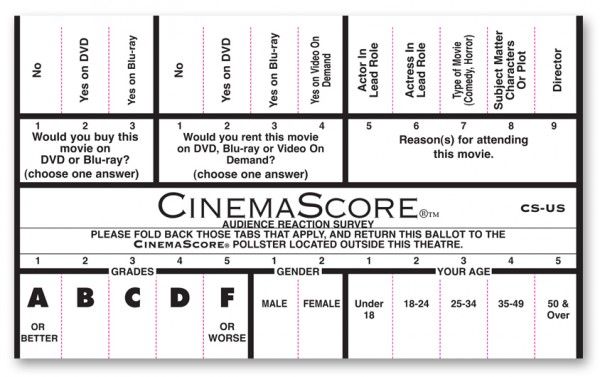Every weekend after a film opens, we get not only its box office, but its “CinemaScore.” It’s a letter grade from A+ to F, but where does it come from? Who applies? And what does it really mean? If you’ve had questions about CinemaScore but were too afraid to ask, we’ve got answers.
Where Does CinemaScore Come From?
CinemaScore has been around since 1978, and you may have even encountered them on an opening weekend. You’ll go to a movie on opening night and someone will hand you a card with various questions on it. You can then fold parts of the card to register your answer. Additionally, you fold parts of the card to register your demographics so that studios can know what men and women of various ages thought.
These scores are usually reported in the trades on opening weekend and then they’re recorded for posterity on CinemaScore’s website. However, these scores only tell part of the story.
So CinemaScore Is Like an Audience’s Rotten Tomatoes Score?
Not exactly. For starters, CinemaScore only does polling on a movie on its opening night. Here’s how they describe their work:
On opening night around the country, CinemaScore polls moviegoers for their opinions on new movie releases. Audience members fill out ballot cards right at the theatre, grading a movie A to F and providing demographic information. CinemaScore uses this direct balloting approach to establish a movie's grade—its overall "CinemaScore."
That means that if you’re not seeing a movie on its opening night, your opinion isn’t counted. So it’s a selective sample size of people who are interested enough in a movie to see it on its opening night as opposed to constantly taking the input of everyone. Additionally, CinemaScore is going out into the world and conducting a poll rather than just letting everyone submit a grade through an online tool.
So What Is CinemaScore Measuring?
Obviously, all grades of movies are subjective. There’s no formula for definitively saying that a movie is a “B” and therefore it will always be a “B” no matter what you think about it. Opinions on art aren’t determined democratically. However, it is a metric that’s useful to studios, but not necessarily with regards to the film’s quality.
What CinemaScore is really measuring is how a film’s marketing lines up with audience expectations. So if you have a movie like Paddington 2, and all of the ads showed an adorable bear getting into mischief, and that’s what the movie delivered, it’s no surprise the film got an “A” grade. But take a movie like mother!, where the ads made it look like a psychological thriller of sorts, and instead it’s a feature-length allegory about how humanity is killing the planet. It got an “F”.
It’s also worth noting that most movies land somewhere in the A to B+ range, which makes sense. Most marketing isn’t deceptive, and studios go to great lengths to pre-sell a movie whether it’s through stars people like, popular source material, or playing up the strongest aspects of the film. Rarely do people feel “cheated”, but more than that, they don’t want to admit that they were duped. You’ve already paid for your ticket and so a film really has to rub people the wrong way to get anything lower than a “B”.
The way CinemaScore functions as a measure of marketing is that people who are seeing a movie on opening night have seen at least something about that movie, and that the marketing was persuasive enough to get people to see the film on opening night. Compare that to people who might see it later in the weekend or in the following weeks who may have been persuaded more by critical response or word of mouth. That’s not to say everyone who sees a movie on opening night was swayed solely by the marketing, but polling those specific audience members is the best way to measure those who were driven by the marketing more than other factors.
So the next time you see a film got a certain CinemaScore, keep in mind that it’s not a measure of the film’s quality or even what audiences as a whole think about a movie. It’s a measure of marketing, and how well expectations lined up with the finished feature.




